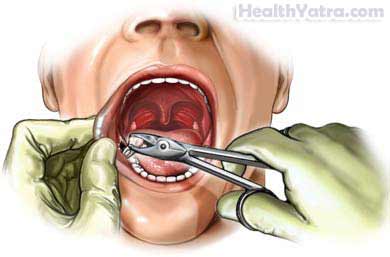تعريف
This is a procedure to remove a tooth.

أسباب هذا الإجراء
While dental techniques can save many teeth, a tooth may need to be removed if it:
- Is too badly damaged or decayed to be saved by a root canal
- Has an infected nerve
- Is affecting normal tooth growth
- Is loose from advanced gum disease
- Has a loss of supporting bone, gums, or tissue
المضاعفات المحتملة
Complications are rare, but no procedure is completely free of risk. If you are planning to have a tooth extracted, your dentist will review a list of possible complications, which may include:
- نزيف
- العدوى
- تلف العصب
تشمل العوامل التي قد تزيد من خطر حدوث مضاعفات ما يلي:
- التدخين
- سوء التغذية
- Poor overall health
- Use of some prescription and non-prescription drugs—Talk to your dentist about any medicine you are taking.
Be sure to discuss these risks with your dentist before the procedure.
ما يمكن توقعه
قبل الإجراء
Your dentist will likely:
- Do a thorough dental exam
- Do an x-ray of the mouth—a test that uses radiation to take a picture of structures inside the body, especially bones
التخدير
Depending on the procedure, your dentist will choose:
- Local anesthesia—just the area that is being operated on is numbed; given as an injection
- General anesthesia —blocks pain and keeps you asleep through the procedure
وصف الإجراء
If the tooth is impacted (buried in the gum), the dentist will remove the overlying gum tissue to expose the tooth. Using forceps, the dentist will grasp the tooth and gently rock it back and forth. This action will loosen the tooth and break the ligaments that hold the tooth in place. The tooth will be pulled, and a blood clot will form in the empty socket. The dentist will pack a gauze pad into the socket. In some cases, the dentist will place a few stitches to close the gum edges.
مباشرة بعد الإجراء
You will need to bite firmly but gently on the gauze pad. This will reduce bleeding and permit a clot to form in the tooth socket. If rapid bleeding continues, replace with a fresh pad every 20-30 minutes. Otherwise, leave the pad in place for 3-4 hours.
كم من الوقت سيستغرق ؟
It often takes about 20 minutes but may take longer for impacted teeth.
كم هو مؤلم ؟
You will feel pain in your jaw. Your dentist may give you pain medicine.
رعاية ما بعد العملية
When you return home, do the following to help ensure a smooth recovery:
- To reduce swelling, apply an ice pack to the area. Apply for 10 minutes at a time.
- Do not dislodge the blood clot that forms in the wound. Do not spit or rinse forcefully in the first 24 hours.
- لا تدخن.
- Do not allow food particles to pack into the socket.
- Do not use drinking straws in the first 24 hours.
- Begin rinsing your mouth 24 hours after the procedure. Use a solution made of ½ teaspoon salt and 8 ounces warm water.
- Eat a soft or liquid diet for the first 24 hours.
- Avoid activity for the first 24 hours. For the next 1-2 days, limit your activity.
- Continue to brush and floss other teeth. This will help prevent infection in the extraction site.
- تأكد من اتباع تعليمات طبيبك.
In the first 24 hours, expect some swelling and bleeding. The initial healing period usually takes about 1-2 weeks. New bone and gum tissue will grow into the gap.
Having a missing tooth can lead to shifting teeth, improper bite, or difficulty chewing. Your dentist may attempt to restore the area with an implant, fixed bridge, or denture.
Call Your Dentist
After arriving home, contact your dentist if any of the following occurs:
- علامات الإصابة, بما في ذلك حمى وقشعريرة
- Redness, swelling, increasing pain, or any discharge from the open socket
- Excessive bleeding continuing for more than four hours after surgery
- ألم لا يمكنك السيطرة عليه بالأدوية التي أعطيت لك
- سعال ، ضيق تنفس ، ألم في الصدر ، غثيان أو قيء شديد
- أي أعراض جديدة
في حالة الطوارئ ، اتصل على المساعدة الطبية على الفور.
